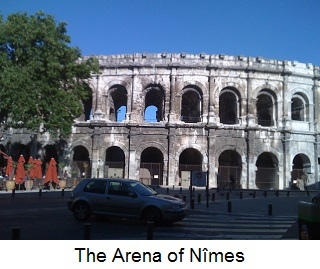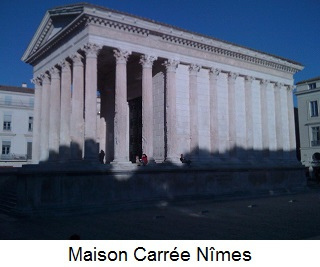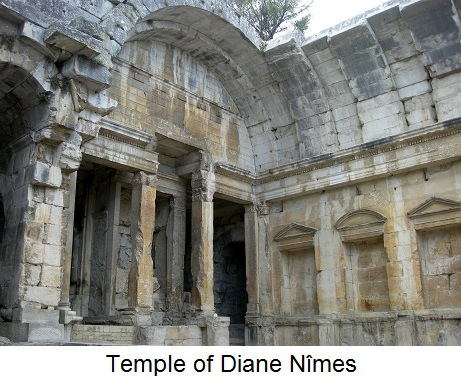A Magnificent Frankenstein
 Last spring, my wife and I took the TGV (bullet train) to Nîmes in the Languedoc-Roussillon region of southern France. It’s a charming city near the Mediterranean, greatly influenced by its Spanish neighbor. Sadly, we arrived a week before the Féria de Pentecôte, when the city hosts week-long bullfights in the ancient Roman amphitheater. After sundown, thousands of visitors flood the streets to party long into the night in the bodegas: temporary bars erected on the wide sidewalks. Next year, we’ll be there, dancing in the streets with other Pentecostal revelers.
Last spring, my wife and I took the TGV (bullet train) to Nîmes in the Languedoc-Roussillon region of southern France. It’s a charming city near the Mediterranean, greatly influenced by its Spanish neighbor. Sadly, we arrived a week before the Féria de Pentecôte, when the city hosts week-long bullfights in the ancient Roman amphitheater. After sundown, thousands of visitors flood the streets to party long into the night in the bodegas: temporary bars erected on the wide sidewalks. Next year, we’ll be there, dancing in the streets with other Pentecostal revelers.Nîmes was an ancient city in southern Gaul that became a Roman colony (Nemausus) around 28 B.C. We were bedazzled by the architecture. The amphitheater lies in the center of town and was built only twenty years after the Roman Colosseum. As we strolled the streets, we marveled that ancient Roman buildings were intermingled with medieval and renaissance structures. Eighteenth- and nineteenth-century apartments were built over Roman foundations, and ruins dot the city.
 So what does this have to do with my historical fiction that takes place in 9th century Rome? Nîmes has the best preserved Roman temple in Europe. There are virtually no preserved temples in Rome. And Nîmes’ amphitheater is in much better shape than Rome’s Colosseum, even though it’s only twenty years newer. Why? Spoliation: the plundering of ancient buildings for new construction.
So what does this have to do with my historical fiction that takes place in 9th century Rome? Nîmes has the best preserved Roman temple in Europe. There are virtually no preserved temples in Rome. And Nîmes’ amphitheater is in much better shape than Rome’s Colosseum, even though it’s only twenty years newer. Why? Spoliation: the plundering of ancient buildings for new construction.Over the centuries, Rome was the victim of the Goths, Visigoths, earthquakes, fire, and gravity. But the greatest despoilers of the city were its own citizens who pilfered valuable veneers of marble and the best quality stone for churches and towers and country villas. Rome was dismantled stone by stone to turn ancient monuments and temples into a newer Christian city. The Forum, once the center of commerce and politics, was leveled. By the ninth century, it was a pasture where oxen grazed on the grasses.
Even the original Saint Peter’s Basilica was razed. “Nothing from the original church was spared, not a mosaic, fresco, or work of art as laborers tore it to the ground, and the destruction didn’t end there. They demolished countless temples and Roman monuments to provide building materials for the new Saint Peter's. Every single stone and brick and piece of marble was ransacked from ancient buildings that once were marvels of the empire. The basilica was a magnificent Frankenstein, constructed from the bones of pagan temples and monuments to the glories of Rome. Even the altar over the tomb of Saint Peter was cast from bronze pinched from the Pantheon, temple of the old Gods.” (Quotes from The Psalter)
 So if you want to see what ancient Roman temples looked like before its citizens destroyed them to build a Christian city, don’t go to Rome. Go to Nîmes. And while you’re there, stop in at one of the bistros and order some wine. Even the ordinary table wine is exquisite. Better yet, visit during the Féria de Pentecôte. Take in the bullfights then party into the night, dancing and singing in the ancient streets of Nemausus.
So if you want to see what ancient Roman temples looked like before its citizens destroyed them to build a Christian city, don’t go to Rome. Go to Nîmes. And while you’re there, stop in at one of the bistros and order some wine. Even the ordinary table wine is exquisite. Better yet, visit during the Féria de Pentecôte. Take in the bullfights then party into the night, dancing and singing in the ancient streets of Nemausus.
date newest »
newest »
 newest »
newest »




It was quite easy to find maps and recreations of Rome during its heyday. It was quite difficult to find maps and drawings of the city during the ninth century—or thereabouts--when it was dilapidated and largely dismantled. I had to wander university libraries, via the internet, to find useful ones that depicted the city as it would have been. I enlarged them and pasted them on my walls so I could imagine what early medieval Rome might have looked like.
Here's a link to digitized recreations of Rome at its peak: http://www.romereborn.virginia.edu/ga...
Even though the city changed dramatically in six hundred years, I have a strong belief that the politicians were quite similar. Play the background music and evoke images of power corrupting.